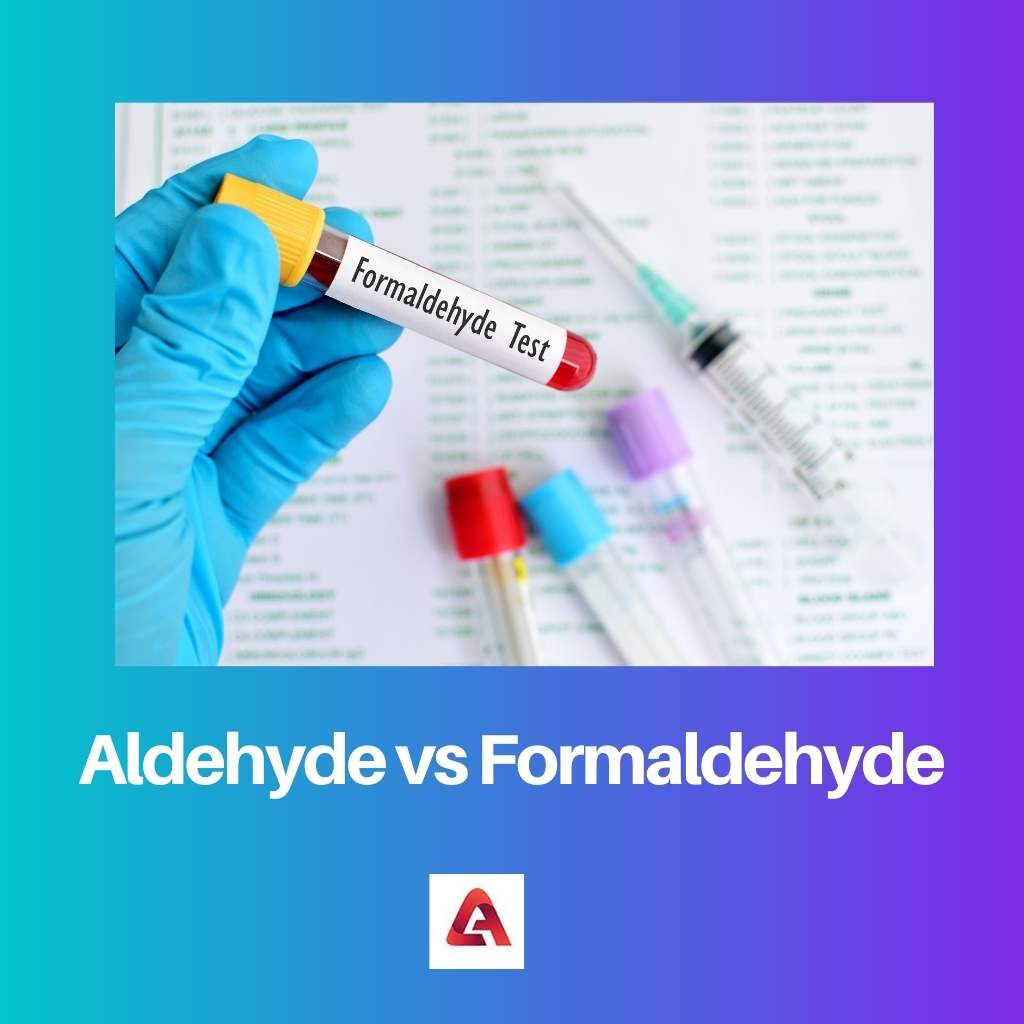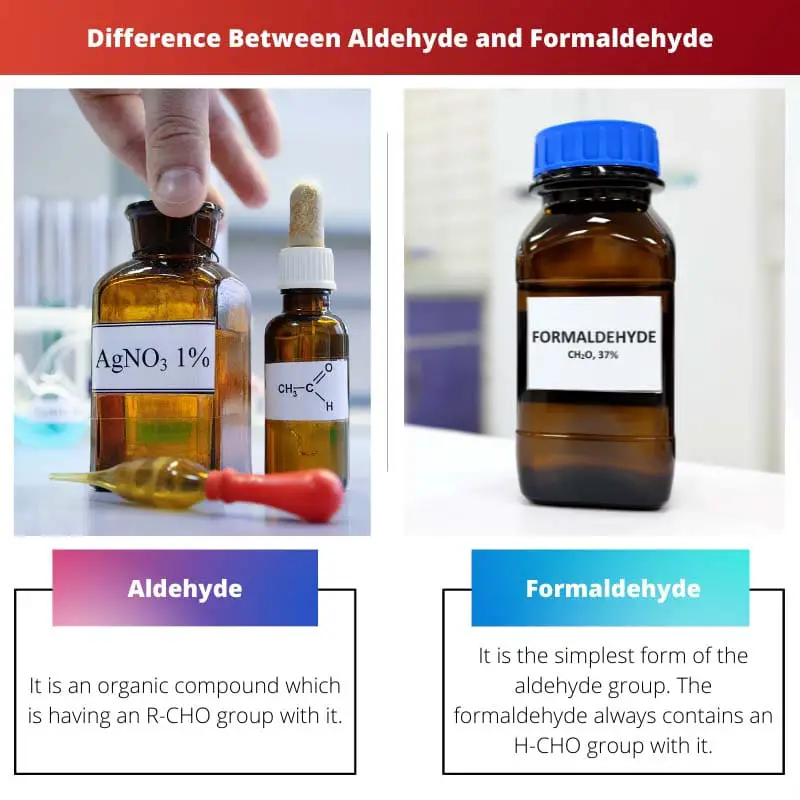Everything is formed of atoms in nature. So naturally, everything has some compounds, and chemicals are everywhere, either they are produced or secreted.
So in organic chemistry, some functional groups separate different chemicals into different groups. Some of these are alcohols, aldehydes, etc. Here are some differences between aldehydes and formaldehyde to clarify the idea about them
Key Takeaways
- Formaldehyde is a simple aldehyde, while other aldehydes have more complex structures and properties.
- Formaldehyde is a colorless, pungent-smelling gas, while other aldehydes may be solid or liquid.
- Formaldehyde has widespread industrial applications, whereas other aldehydes have a variety of uses, including as solvents and intermediates in chemical synthesis.
Aldehyde vs Formaldehyde
The difference between the aldehyde and formaldehyde is that the aldehyde is the main functional group on the other hand, the formaldehyde is the variant of aldehyde. Aldehyde has a very sweet smell, but in contrast to that, formaldehyde has a very pungent smell. Formaldehyde is also very complex in nature in comparison to aldehyde.

An aldehyde is a chemical that comes under the chemistry branch of science. It is a very important chemical in organic chemistry.
It carries a functional group of CHO attached with R. it is also a functional group on its own known as aldehyde or sometimes called formyl group.
Methanol is produced during the oxidation of methane. It is mostly formed during forest fires, tobacco smoke, etc., but this does not exist in nature for a long time.
It gets decomposed by sunlight or any bacteria present in nature. As it exists in gaseous form, it is easier to get decomposed as the bonding atomic bonding is very weak in the gaseous form of matter.
Comparison Table
| Parameters of Comparison | Aldehyde | Formaldehyde |
|---|---|---|
| Definition | It is an organic compound which is having an R-CHO group with it | It is the simplest form of the aldehyde group. The formaldehyde always contains an H-CHO group with it |
| Structure | It has a special form that is it has an R group attached to a CHO group | The specialty of this chemical is that it has one hydrogen attached to a carbonyl group |
| Matter type | It normally exists in gas or liquid type matter | It is mostly found in gaseous form |
| Smell | This compound carries a sweet and pleasant smell | This compound carries a pungent smell |
| Chemical formation | The chemical formation is comparatively simple | The chemical formation is very complex |
What is Aldehyde?
An aldehyde is a chemical that comes under the chemistry branch of science. It is a very important chemical in organic chemistry.
It carries a functional group of CHO attached with R. it is also a functional group on its own known as aldehyde or sometimes called formyl group.
This aldehyde compound or functional group has a chemical structure. The chemical structure is like it has a carbon atom (C) in the middle with three bonding. One arm of the bond has a hydrogen atom (H) connected in a single bond.
The other hand has an oxygen atom (O) connected with carbon in the double bond. The third arm has the R. this R can be any other compound like formaldehyde, carbon, hydrogen, etc.
This compound exists in gaseous or liquid form. They have different types of characteristics and features. The variant in the characteristics is due to the remaining compound attached to the third arm of the carbon atom.
If the remainder compound is small, then the aldehyde is soluble in nature. Some aldehydes are also volatile in nature. Usually, aldehydes carry a very sweet and pleasant smell, but it may vary depending on the remainder compound.
For example, if the compound is formaldehyde, the smell will become pungent.

What is Formaldehyde?
Formaldehyde is a special type of aldehyde and the simplest form. This compound has an aldehyde functional group attached to a hydrogen atom. Aldehyde compound or functional group has a chemical structure.
The chemical structure is like it has a carbon atom (C) in the middle with three bonding.
One arm of the bond has a hydrogen atom (H) connected in a single bond. The other hand has an oxygen atom (O) connected with carbon in the double bond.
The third arm has the R. this R can be any other compound. Like in this matter, this third branch has hydrogen (H).
This compound normally exists in gaseous form in nature. The IUPAC (International Union of Pure and Applied Chemistry) name for this compound is Methanol. Methanol is produced during the oxidation of methane.
It is mostly formed during forest fires, tobacco smoke, etc., but this does not exist in nature for a long time. It gets decomposed by sunlight or any bacteria present in nature.
As it exists in gaseous form, it is easier to get decomposed as the bonding atomic bonding is very weak in the gaseous form of matter.
The smell of formaldehyde is very pungent. It has many uses in the real world. This chemical is used as a drug tester, disinfectant, and even used for preservation. It is also used in photography to wash color photographs.
Main Differences Between Aldehyde and Formaldehyde
- Aldehyde is an organic compound which is having an R-CHO group with it on the other hand, formaldehyde is the simplest form of the aldehyde group. Formaldehyde always contains an H-CHO group.
- Aldehyde has a special form, that is, it has an R group attached to a CHO group. In comparison, the speciality of formaldehyde is that it has one hydrogen attached to a carbonyl group.
- Aldehyde normally exists in gas or liquid-type matter on the other hand, formaldehyde is mostly found in gaseous form.
- Aldehyde carries a sweet and pleasant smell, but in contrast to that, formaldehyde carries a pungent smell.
- The chemical formation of aldehyde is comparatively simple, but in comparison to that, the chemical formation of formaldehyde is very complex.

- https://www.sciencedirect.com/science/article/pii/S0891584900002264
- https://www.tandfonline.com/doi/abs/10.3109/10409239209082565

Aldehyde and formaldehyde illustrate the intricate complexity of molecular structure, and it’s fascinating to see how they share similarities and differences through the lens of organic chemistry.
Organic chemistry is like nature’s artistry. Both aldehyde and formaldehyde, while differing in nature, contribute to the rich tapestry of the environment.
The juxtaposition of aldehyde and formaldehyde encapsulates the dichotomous nature of organic chemistry, shedding light on the diverse characteristics and applications of these compounds.
Indeed, the distinctive odors of aldehyde and formaldehyde provide a sensory contrast that resonates with the broader dichotomies present in organic chemistry.
The divergent uses of aldehyde and formaldehyde underscore the multifaceted roles they play in various scientific and industrial domains, underscoring the depth of their significance.
The impact of aldehyde and formaldehyde on industrial, medical, and chemical fields cannot be overstated. Understanding their differences can lead to significant advancements in these areas.
The chemical formation and properties of aldehyde and formaldehyde are intriguing. Examining the nuances between these compounds reveals essential insights into their behavior.
The overlapping occurrences of aldehyde and formaldehyde in nature are truly beautiful and frightening. We must observe and appreciate how these chemicals affect our daily lives.